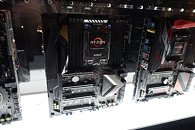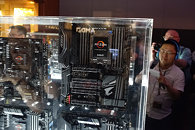- Joined
- Oct 9, 2007
- Messages
- 47,291 (7.53/day)
- Location
- Hyderabad, India
| System Name | RBMK-1000 |
|---|---|
| Processor | AMD Ryzen 7 5700G |
| Motherboard | ASUS ROG Strix B450-E Gaming |
| Cooling | DeepCool Gammax L240 V2 |
| Memory | 2x 8GB G.Skill Sniper X |
| Video Card(s) | Palit GeForce RTX 2080 SUPER GameRock |
| Storage | Western Digital Black NVMe 512GB |
| Display(s) | BenQ 1440p 60 Hz 27-inch |
| Case | Corsair Carbide 100R |
| Audio Device(s) | ASUS SupremeFX S1220A |
| Power Supply | Cooler Master MWE Gold 650W |
| Mouse | ASUS ROG Strix Impact |
| Keyboard | Gamdias Hermes E2 |
| Software | Windows 11 Pro |
Here are some of the first pictures of AMD socket SP3r2 (LGA 4094) motherboards for Ryzen Threadripper HEDT processors. The socket is visibly bigger than Intel LGA2066, and is flanked by eight DDR4 DIMM slots. The other characteristic feature of these boards is that they feature up to three PCI-Express 3.0 x16 slots with full x16 wiring, taking advantage of the 64-lane PCIe root complex, with the fourth slot splitting away x8 lanes from the third slot. This is unlike Intel, where after you've spend $999 on their 10-core processor, you can only run up to two slots at x16.
The first motherboard on our tour is an ASRock X399 Fatal1ty Gaming 9. This board is loaded for bear with four x16 slots (all of which are wired to the CPU), eight DDR4 DIMM slots for the quad-channel memory interface, 32 Gb/s M.2 and U.2 storage connectivity, and at least four of the eight SATA 6 Gb/s ports that come directly from the CPU for the least latency. An interesting observation here is that all three boards we've seen draw power from just a single 8-pin EPS connector besides 24-pin ATX, unlike several LGA2066 boards that over a second EPS or 4-pin ATX input for the CPU VRM. Could this mean that AMD also beat Intel with HEDT energy-efficiency?



Next up is the ASRock X399 Taichi, which appears to be based on the same PCB as the Fatal1ty Gaming 9, but with white+black color scheme, and different heatsink designs. Both boards from ASRock feature 802.11ac+BT4.1 WLAN, in addition to three wired networking interfaces, one of which is 10 GbE.
Lastly, there's the GIGABYTE X399 Aorus Gaming 7. This board has a more restrained design scheme than ASRock, and gives you reinforced DDR4 and PCIe slots, besides three 32 Gb/s M.2 slots, and two wired network interfaces, 802.11ac WLAN, and GIGABYTE's highest-grade onboard audio solution, featuring ESS Sabre DAC, and the highest grade audio capacitors.
View at TechPowerUp Main Site
The first motherboard on our tour is an ASRock X399 Fatal1ty Gaming 9. This board is loaded for bear with four x16 slots (all of which are wired to the CPU), eight DDR4 DIMM slots for the quad-channel memory interface, 32 Gb/s M.2 and U.2 storage connectivity, and at least four of the eight SATA 6 Gb/s ports that come directly from the CPU for the least latency. An interesting observation here is that all three boards we've seen draw power from just a single 8-pin EPS connector besides 24-pin ATX, unlike several LGA2066 boards that over a second EPS or 4-pin ATX input for the CPU VRM. Could this mean that AMD also beat Intel with HEDT energy-efficiency?



Next up is the ASRock X399 Taichi, which appears to be based on the same PCB as the Fatal1ty Gaming 9, but with white+black color scheme, and different heatsink designs. Both boards from ASRock feature 802.11ac+BT4.1 WLAN, in addition to three wired networking interfaces, one of which is 10 GbE.
Lastly, there's the GIGABYTE X399 Aorus Gaming 7. This board has a more restrained design scheme than ASRock, and gives you reinforced DDR4 and PCIe slots, besides three 32 Gb/s M.2 slots, and two wired network interfaces, 802.11ac WLAN, and GIGABYTE's highest-grade onboard audio solution, featuring ESS Sabre DAC, and the highest grade audio capacitors.
View at TechPowerUp Main Site










 .
. a quick search from eBay seems that the cheapest ones were ~17eur
a quick search from eBay seems that the cheapest ones were ~17eur 
